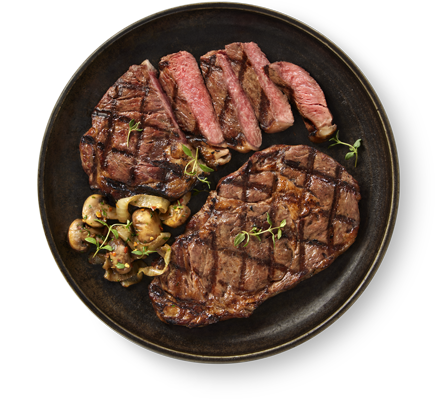How to Cook the Perfect Steak (Hint: It’s Easier Than You Think)
Cooking a steak from Prairie Ranchers Beef requires a slightly different approach than you might be used to with conventional beef. The unique qualities that make our beef exceptional with complex flavour — also mean it deserves special handling in your kitchen. But don't worry, with a few simple adjustments to your technique, you'll be cooking our beautifully marbled, grass-fed and finished steaks to perfection every time.
Start with Room Temperature
Always bring your steak to room temperature before cooking. Remove it from the refrigerator at least 30 minutes before you plan to cook. This ensures even cooking and helps prevent the steak from becoming tough.
Season Simply
Premium quality beef has a richer, more nuanced flavor profile that deserves to shine. Season with sea salt and freshly ground pepper to taste, applying about 15 minutes before cooking. While marinades aren't necessary, a light coating of olive oil (or butter) helps prevent sticking and promotes beautiful browning.
Lower Heat, Shorter Time
The most common mistake when cooking grass-fed and finished beef is using too much heat. While our steaks feature beautiful marbling, it still cooks approximately 30% faster than conventional beef. Use medium to medium-high heat rather than high heat, and reduce your usual cooking time accordingly. For the juiciest results, aim for these internal temperatures:
- Rare: 51°C (125°F)
- Medium-rare: 54°C (130°F)
- Medium: 60°C (140°F)
Remember that medium-rare (54-57°C/130-135°F) is often considered ideal for grass-fed beef, as this is when the marbling melts, bringing more flavour and tenderness to the meat. For best results, remove your steak from heat when it's about 3-5°C (5-10°F) below your target temperature, as it will continue cooking while resting.
For a 1-inch thick ribeye or strip steak, try:
- Rare: 2-3 minutes per side
- Medium-rare: 3-4 minutes per side
- Medium: 4-5 minutes per side
Rest Is Essential
Allow your steak to rest for at least 5 minutes after cooking. During this time, the juices redistribute throughout the meat, ensuring every bite is flavorful and juicy. For larger steaks, rest for up to 10 minutes.
Slice Against the Grain
Always cut perpendicular to the muscle fibres (against the grain) to maximize tenderness. This is especially important for grass-fed and finished beef, which has a denser muscle structure. Our nutrient-rich beef offers exceptional nutrition and flavour, thanks to our regenerative grazing practices and commitment to raising cattle as nature intended. With these simple adjustments to your cooking technique, you'll experience the true potential of grass-fed and finished beef — a clean, complex taste that reflects the diverse prairie grasses our animals thrive on.
Prefer to Grill?
If you prefer to grill your steaks, the same principles apply, with a few adjustments. Prepare a dual-zone grill with both direct and indirect heat areas. Temperatures of 204-232°C (400-450°F) for direct heat and 121-177°C (250-350°F) for indirect heat are ideal.
Next, sear your beautifully marbled steak over direct heat for 1-2 minutes per side to develop grill marks, then move to indirect heat to finish cooking. This two-zone method preserves moisture while still achieving that tasty chargrilled flavour. Remember that grass-fed beef still cooks faster on the grill, so keep a close eye on it and use a meat thermometer to avoid overcooking.


